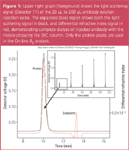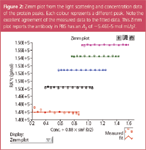Automated, On-line Second Virial Coefficient Measurements
The Application Notebook
Measurement of weak protein-solvent interactions is essential in a wide array of processes, such as stabilization of therapeutic protein formulations, purification of protein mixtures and crystallization of proteins. Both self and cross-association can be quantified by the second virial coefficient (A2).
A2 values are dependent on both the protein and its solvent: Temperature, salinity, pH, chemical excipients, and so on, can induce dramatic shifts in A2. Positive A2 corresponds to repulsive intermolecular interaction, whereas negative A2 corresponds to attractive intermolecular interaction. Rapid determination of the buffer conditions yielding an optimal A2, such as a positive A2 for formulations, or a slightly negative A2 for crystallization, is highly desirable.

Figure 1
In the past, such measurements were labour intensive, time consuming and expensive in terms of time and protein: For each buffer condition tested, extensive dialysis and preparation of multiple concentrations were required. Additionally, each concentration had to be injected manually. Wyatt Technology has overcome these issues, and developed an accurate, automated method for measuring A2 on-line. In our on-line A2 method, only a single protein stock solution is needed for an entire series of measurements.
In addition to complete automation and on-line dialysis, the on-line A2 method has the added benefit of flushing the light scattering flow cell between each injection, helpful for researchers working with "sticky" proteins.
The Trainoff-Wyatt On-line A2 method is as follows: A sample delivery unit, such as a standard autosampler, delivers a sequence of 5 or more different volumes (such as 20 μ to 200 μL) through an optional size exclusion chromatography column (SEC) or a desalting column, to a DAWN or miniDAWN light scattering instrument and an Optilab RI. The Optilab RI serves as a concentration detector and also records the complete dialysis of each injection.

Figure 2
The On-line A2 method will enable researchers to fully use the second viral coefficient as an important indicator of protein–protein interaction. The historic impediments to this type of measurement, lengthy sample preparation and experimental labour, have been overcome. Now, using standard chromatography equipment and Wyatt detectors, an entire series of A2 values can be determined in less then a day!
DAWN, miniDAWN, ASTRA, Optilab and the Wyatt Technology logo are registered trademarks of Wyatt Technology Corporation. ©2007 Wyatt Technology Corporation 7/20/07
Amy Hanlon, Wyatt Technology Corp., Santa Barbara, California, USA.

Wyatt Technology Corporation
6300 Hollister Avenue, Santa Barbara, California 93117, USA
tel. +1 805 681 9009 fax +1 805 681 0123
E-mail: info@wyatt.com Website: www.wyatt.com

New Method Explored for the Detection of CECs in Crops Irrigated with Contaminated Water
April 30th 2025This new study presents a validated QuEChERS–LC-MS/MS method for detecting eight persistent, mobile, and toxic substances in escarole, tomatoes, and tomato leaves irrigated with contaminated water.
University of Tasmania Researchers Explore Haloacetic Acid Determiniation in Water with capLC–MS
April 29th 2025Haloacetic acid detection has become important when analyzing drinking and swimming pool water. University of Tasmania researchers have begun applying capillary liquid chromatography as a means of detecting these substances.
Prioritizing Non-Target Screening in LC–HRMS Environmental Sample Analysis
April 28th 2025When analyzing samples using liquid chromatography–high-resolution mass spectrometry, there are various ways the processes can be improved. Researchers created new methods for prioritizing these strategies.
Free Poster: NDSRI Risk Assessment and Trace-Level Analysis of N-Nitrosamines
April 25th 2025With increasing concern over genotoxic nitrosamine contaminants, regulatory bodies like the FDA and EMA have introduced strict guidelines following several high-profile drug recalls. This poster showcases a case study where LGC and Waters developed a UPLC/MS/MS method for quantifying trace levels of N-nitroso-sertraline in sertraline using Waters mass spectrometry and LGC reference standards.
New TRC Facility Accelerates Innovation and Delivery
April 25th 2025We’ve expanded our capabilities with a state-of-the-art, 200,000 sq ft TRC facility in Toronto, completed in 2024 and staffed by over 100 PhD- and MSc-level scientists. This investment enables the development of more innovative compounds, a broader catalogue and custom offering, and streamlined operations for faster delivery. • Our extensive range of over 100,000 high-quality research chemicals—including APIs, metabolites, and impurities in both native and stable isotope-labelled forms—provides essential tools for uncovering molecular disease mechanisms and exploring new opportunities for therapeutic intervention.

.png&w=3840&q=75)

.png&w=3840&q=75)



.png&w=3840&q=75)



.png&w=3840&q=75)











